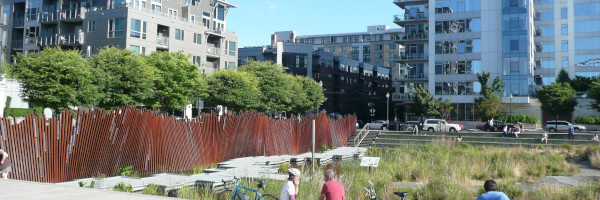Regenerative Urbanism: Difference between revisions
No edit summary |
No edit summary |
||
| Line 8: | Line 8: | ||
|summary=Regenerative urbanism is a philosophy and approach to urban design and development that aims to create cities and communities that not only sustain themselves, but also improve the health and well-being of both the natural environment and the people who live in them. This can be achieved through a variety of strategies, such as incorporating green spaces, promoting walkability and bike-friendliness, and designing buildings and infrastructure that are energy-efficient and make use of renewable resources. The goal of regenerative urbanism is to create cities that are resilient, adaptive, and regenerative, and that contribute positively to the overall ecological, social, and economic well-being of the planet. | |summary=Regenerative urbanism is a philosophy and approach to urban design and development that aims to create cities and communities that not only sustain themselves, but also improve the health and well-being of both the natural environment and the people who live in them. This can be achieved through a variety of strategies, such as incorporating green spaces, promoting walkability and bike-friendliness, and designing buildings and infrastructure that are energy-efficient and make use of renewable resources. The goal of regenerative urbanism is to create cities that are resilient, adaptive, and regenerative, and that contribute positively to the overall ecological, social, and economic well-being of the planet. | ||
}} | }} | ||
There are several principal approaches to incorporating green spaces into urban design, including: | |||
#'''Parks and gardens''': Creating large public parks and gardens in the heart of cities provides green spaces for people to enjoy, as well as helping to improve air quality and reducing the urban heat island effect. | |||
#'''Green roofs and walls''': Incorporating green roofs and walls on buildings can help to reduce energy consumption, improve air quality, and create additional green spaces in urban areas. | |||
#'''Rainwater harvesting''': Incorporating systems for harvesting and reusing rainwater can help to reduce the strain on municipal water systems and promote sustainable water management. | |||
#'''Street trees and green corridors''': Planting street trees and creating green corridors can help to improve air quality, reduce the urban heat island effect, and provide additional green spaces for people to enjoy. | |||
#'''Bioswales and green infrastructure''': Incorporating bioswales and other forms of green infrastructure into urban design can help to improve water quality, reduce flooding, and create additional green spaces. | |||
#'''Community gardens and urban agriculture''': Creating community gardens and promoting urban agriculture can help to increase access to fresh fruits and vegetables, promote sustainable food systems, and create additional green spaces in urban areas. | |||
#'''Greenbelt preservation''': Preserving existing greenbelts and natural areas around cities can help to protect biodiversity and provide additional green spaces for people to enjoy. | |||
__NOTOC__ | __NOTOC__ | ||
=Companies= | =Companies= | ||
Revision as of 21:58, January 15, 2023
| Buildings | ||||||||||||||||||||||||||||||||||||
|---|---|---|---|---|---|---|---|---|---|---|---|---|---|---|---|---|---|---|---|---|---|---|---|---|---|---|---|---|---|---|---|---|---|---|---|---|

| ||||||||||||||||||||||||||||||||||||
| Sectors | Buildings | |||||||||||||||||||||||||||||||||||
| Contact | Charles Kelley | |||||||||||||||||||||||||||||||||||
| Topics |
| |||||||||||||||||||||||||||||||||||
Activities
Press
| ||||||||||||||||||||||||||||||||||||
- Authors
Regenerative urbanism is a philosophy and approach to urban design and development that aims to create cities and communities that not only sustain themselves, but also improve the health and well-being of both the natural environment and the people who live in them. This can be achieved through a variety of strategies, such as incorporating green spaces, promoting walkability and bike-friendliness, and designing buildings and infrastructure that are energy-efficient and make use of renewable resources. The goal of regenerative urbanism is to create cities that are resilient, adaptive, and regenerative, and that contribute positively to the overall ecological, social, and economic well-being of the planet.
There are several principal approaches to incorporating green spaces into urban design, including:
- Parks and gardens: Creating large public parks and gardens in the heart of cities provides green spaces for people to enjoy, as well as helping to improve air quality and reducing the urban heat island effect.
- Green roofs and walls: Incorporating green roofs and walls on buildings can help to reduce energy consumption, improve air quality, and create additional green spaces in urban areas.
- Rainwater harvesting: Incorporating systems for harvesting and reusing rainwater can help to reduce the strain on municipal water systems and promote sustainable water management.
- Street trees and green corridors: Planting street trees and creating green corridors can help to improve air quality, reduce the urban heat island effect, and provide additional green spaces for people to enjoy.
- Bioswales and green infrastructure: Incorporating bioswales and other forms of green infrastructure into urban design can help to improve water quality, reduce flooding, and create additional green spaces.
- Community gardens and urban agriculture: Creating community gardens and promoting urban agriculture can help to increase access to fresh fruits and vegetables, promote sustainable food systems, and create additional green spaces in urban areas.
- Greenbelt preservation: Preserving existing greenbelts and natural areas around cities can help to protect biodiversity and provide additional green spaces for people to enjoy.
Companies
Reports

|
Cascadia 2050 Vision - Moving to Climate Action | |
| The Cascadia mega-region, running from Portland through Seattle to Vancouver, British Columbia, has become
synonymous with building a better future. Home to so many natural assets and incredible innovation and talent – one of our greatest strengths is partnership. Now is the time to partner to address one of the greatest challenges of our time: the threat of climate change to the region and the world. | ||








